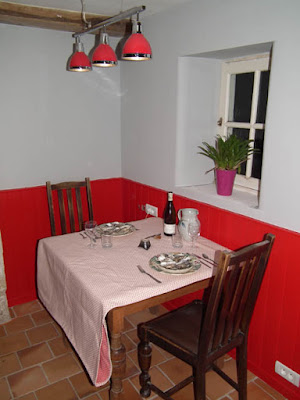January
We were given medals by the town, had a party to raise funds for flood relief in Australia, blogged for a whole week about Australia because it was Australia Day on the 26th and I wrote about my family emigrating to Australia in 1966. In the house we were insulating and plasterboarding the kitchen.
 February
FebruaryWe went to Retromobile and did some shoe shopping (as you do). In the house we continued work on the kitchen and applied some finishing touches to the structural work in the attic bathroom.
March
In March we started getting really serious about the kitchen, ordering our tiles, having the pipework for our cooker installed, and visiting kitchen shops to start getting prices. We also started proper work for the year, visiting Chenonceau for the first time on the 24th.
April
was paint and plaster month. We worked on the office, the kitchen and the attic bathroom. We had time off though, for bar-b-q-ing (I know, but however you "spell" that, it's wrong) and the Fête. The kitchen kind of progressed when Angela and Dennis delivered our range hood and we decided not to use a kitchen specialist because they are for the most part thieves and rogues. Elsewhere (by that I mean outside) it didn't rain.
April would usually be early spring, but this year was very mild
 May
MayMay was the month where we celebrated the 5th anniversary of seeing the house for the first time and the second anniversary of moving here. We did more plaster & paint stuff in the attic bathroom and kitchen, although we did get professional help too. All the while the drought continued.
June
What a month - Paris, parents, bathroom, and kitchen, in various orders. Some even more than once. In between all that, we worked, and the drought continued.
July
Parents again, but this time in Preuilly. The kitchen was installed (sans worktops). We worked lots. It was hot a lot of the time - and very dry.
A bell on the side of Montresor chateau.
We visited twice this year
We visited twice this year
 August
AugustIt rained - eventually, and we continued to work hard with Célestine. We didn't get much work done on the house, as August is when businesses close around here. This meant we had time to watch some competitive ploughing, part of the Comice Rural.
September
Work on the house involved paint (again) and fixing the landings for the staircase. September was a busy month with clients, but we did find time to fit in a weekend in Paris.
October
Suddenly life got really busy again - we did tiling, painting, chaux chanvre, and the worktops for the kitchen arrived. We were also blessed with more clients (so that was Chenonceau again) and a visit from a dear friend.
Whatever it was they were looking at,
it obviously deserved the !
it obviously deserved the !
 November
Novemberfound us still dealing with chaux chanvre, but we did also find time to install our niche. We had more clients, but then Célestine broke. I also had a couple of days in London with my father.
December
A lot happened this month, mainly paint based, but we also got the kitchen and dining room more or less finished. The downstairs toilet was also painted and reinstalled. Then we had a storm, which didn't affect us too badly, but other people suffered.
112,982 visitors to the blog
368 blog posts
50 species of butterfly recorded
21 visits to the Chenonceau carpark
4 visits to Paris
and that's our 2011 for you
Simon















































